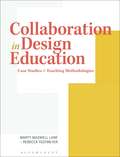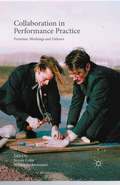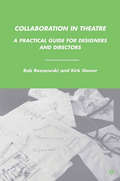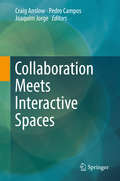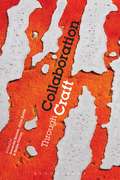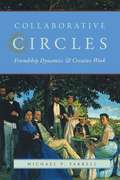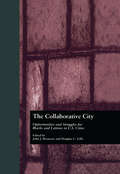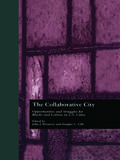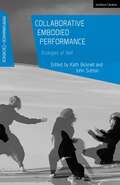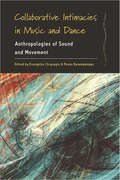- Table View
- List View
Collaboration in Design Education
The book is a comprehensive guide for students and practitioners who want to take a collaborative approach in their design practice. Authors Marty Maxwell Lane and Rebecca Tegtmeyer introduce a range of case study collaborations, both face-to-face and remote, and between individuals and groups. The book addresses the basics of getting started, planning ahead and reflecting on outcomes, alongside the issues that come up in collaborative work, e.g. cross-cultural exchange, or managing roles within a diverse team. Editorial commentary runs throughout the chapter introductions and case studies, with informatics illustrating key concepts and expanded 'call out' points in the martin. More complex case studies offer a 'deep dive' section to explain and share further details of the featured projects.
Collaboration in Performance Practice: Premises, Workings and Failures
by Noyale Colin Stefanie SachsenmaierCollaboration between artists has been practised for centuries, yet over recent decades the act of collaborating has taken different meanings. This publication examines cultural, philosophical and political issues tied to specific instances of collaborative practice in the performing arts. Leading scholars and practitioners review historical developments of collaborative practice and reveal what it means to work together in creative contexts at the beginning of the twenty-first century. Key questions addressed include how artists are developing new ways of working together in response to contemporary economic trends, the significance of collaborating across culture and what opportunities are apparent when co-working between genres and disciplines. Noyale Colin and Stefanie Sachsenmaier present these perspectives in three thematic sections which interrogate the premises of collective intentions, the working strategies of current practitioners, as well as the role of failure and compromise in collaborative modes of creative work. This volume is an invaluable resource for scholars, practitioners and those interested in contemporary artistic methods of working.
Collaboration in Theatre: A Practical Guide for Designers and Directors
by Rob Roznowski K. DomerFinally, a book that addresses one of the most important elements of theatrical production, the collaboration between director and designer. This accessible and helpful guide addresses the crucial relationship between theatrical production team members. Experienced director Rob Roznowski and designer Kirk Domer offer prescriptive and proactive tips to create the ideal production environment. This three part book combines theory, practice, and exercises and will help anyone involved in the theatre to develop appropriate and healthy collaborative skills. Topics Covered Include: * The Vocabulary of Collaboration * Script Analysis * Responses to Criticism * Research Methods
Collaboration Meets Interactive Spaces: Theory And Practice
by Craig Anslow Pedro Campos Joaquim JorgeThis book explores the technological advances and social interactions between interactive spaces, surfaces and devices, aiming to provide new insights into emerging social protocols that arise from the experimentation and long-term usage of interactive surfaces. This edited volume brings together researchers from around the world who investigate interactive surfaces and interaction techniques within large displays, wearable devices, software development, security and emergency management. Providing both theory and practical case studies, the authors look at current developments and challenges into 3D visualization, large surfaces, the interplay of mobile phone devices and large displays, wearable systems and head mounted displays (HMD’S), remote proxemics and interactive wall displays and how these can be employed throughout the home and work spaces. Collaboration Meets Interactive Spaces is both for researchers and industry practitioners, providing readers with a coherent narrative into the current state-of-the-art within interactive surfaces and pervasive display technology, providing necessary tools and techniques as interactive media increasingly permeates everyday contexts.
Collaboration Technologies and Social Computing: 25th International Conference, CRIWG+CollabTech 2019, Kyoto, Japan, September 4–6, 2019, Proceedings (Lecture Notes in Computer Science #11677)
by Hideyuki Nakanishi Hironori Egi Irene-Angelica Chounta Hideyuki Takada Satoshi Ichimura Ulrich HoppeThis book constitutes the refereed proceedings of the 25th International Conference, CRIWG+CollabTech 2019, held in Kyoto, Japan in September 2019. The 12 full papers presented in this book together with 8 work-in-progress papers were carefully reviewed and selected from 28 submissions, and the program also included an invited talk. This year presented a merger of the CRIWG and CollabTech conferences after having been jointly held since 2014. The papers published in this proceedings focus on innovative collaboration technologies and social computing.
Collaboration Technologies and Social Computing: 26th International Conference, CollabTech 2020, Tartu, Estonia, September 8–11, 2020, Proceedings (Lecture Notes in Computer Science #12324)
by Alexander Nolte Claudio Alvarez Reiko Hishiyama Irene-Angelica Chounta María Jesús Rodríguez-Triana Tomoo InoueThis book constitutes the proceedings of the 26th International Conference on Collaboration Technologies and Social Computing, CollabTech 2020. The conference was scheduled to take place in Tartu, Estonia, in September 2020. It was held virtually due to the COVID-19 pandemic. The 10 full and 5 work-in-progress papers presented in this volume were carefully reviewed and selected from 25 submissions.
Collaboration Through Craft
by Amanda Ravetz Alice Kettle Helen FelceyOffering a challenging new argument for the collaborative power of craft, this ground-breaking volume analyses the philosophies, politics and practicalities of collaborative craft work. The book is accessibly organised into four sections covering the cooperation and compromises required by the collaborative process; the potential of recent technological advances for the field of craft; the implications of cross-disciplinary and cross-cultural collaborations for authority and ownership; and the impact of crafted collaborations on the institutions where we work, learn and teach. With cutting-edge essays by established makers and artists such as Allison Smith (US) and Brass Art (UK), curator Lesley Millar, textile designer Trish Belford and distinguished thinker Glenn Adamson, Collaborating Through Craft will be essential reading for students, artists, makers, curators and scholars across a number of fields.
Collaboration Through Craft
by Amanda Ravetz Alice Kettle Helen FelceyOffering a challenging new argument for the collaborative power of craft, this ground-breaking volume analyses the philosophies, politics and practicalities of collaborative craft work. The book is accessibly organised into four sections covering the cooperation and compromises required by the collaborative process; the potential of recent technological advances for the field of craft; the implications of cross-disciplinary and cross-cultural collaborations for authority and ownership; and the impact of crafted collaborations on the institutions where we work, learn and teach. With cutting-edge essays by established makers and artists such as Allison Smith (US) and Brass Art (UK), curator Lesley Millar, textile designer Trish Belford and distinguished thinker Glenn Adamson, Collaborating Through Craft will be essential reading for students, artists, makers, curators and scholars across a number of fields.
Collaborations in Architecture and Engineering
by Clare Olsen Sinead Mac NamaraCollaborations in Architecture and Engineering focuses on team-building and problem-solving between architects and engineers to prepare you for working together in practice. It provides an overview and foundation for interdisciplinary collaboration so that you can create innovative proposals for optimization, performance, and aesthetic goals. It also shows you how to solve real-world problems and how to engage creatively with technological challenges so that you can be a productive member of any team. The authors, an architect and an engineer, share guidelines learned from their experiences and observations on how to insure productive communication, engage in interdisciplinary discussions, and establish common goals and values. Throughout the book are many case study examples of architect and engineer collaborations––such as those between SANAA and Mutsuro Sasaki, Foster + Partners and Buro Happold, Steven Holl and Guy Nordenson, and SHoP Architects and ARUP. The book also includes a discussion about integrated project delivery (IPD) contracts and administration, so you'll be ready for better integration.
Collaborations in Architecture and Engineering
by Clare Olsen Sinead Mac NamaraCollaborations in Architecture and Engineering focuses on team-building and problem-solving between architects and engineers to prepare you for working together in practice. It provides an overview and foundation for interdisciplinary collaboration so that you can create innovative proposals for optimization, performance, and aesthetic goals. It also shows you how to solve real-world problems and how to engage creatively with technological challenges so that you can be a productive member of any team. The authors, an architect and an engineer, share guidelines learned from their experiences and observations on how to insure productive communication, engage in interdisciplinary discussions, and establish common goals and values. Throughout the book are many case study examples of architect and engineer collaborations––such as those between SANAA and Mutsuro Sasaki, Foster + Partners and Buro Happold, Steven Holl and Guy Nordenson, and SHoP Architects and ARUP. The book also includes a discussion about integrated project delivery (IPD) contracts and administration, so you'll be ready for better integration.
Collaborations in Architecture and Engineering
by Clare Olsen Sinead Mac NamaraThis new edition of Collaborations in Architecture and Engineering explores how to effectively develop creative collaborations among architects and engineers. The authors, an architect and an engineer, share insights gained from their experiences and research on fostering productive communication, engaging in interdisciplinary discussions, and establishing common design goals. Together, they share the tools, methods, and best practices deployed by prominent innovative architects and engineers to provide readers with the key elements for success in interdisciplinary design collaborations. The book offers engaging stories about prominent architect and engineer collaborations––such as those between SANAA and Sasaki and Partners, Adjaye Associates and Silman, Grafton Architects and AKT II, Studio Gang and Arup, Foster + Partners and Buro Happold, Steven Holl Architects and Guy Nordenson and Associates, and among the engineers and architects at SOM. In the second edition, the newly added case studies showcase extraordinary buildings across the globe at a range of scales and typologies, tracing the facets of high-quality collaborations. Through the examples of these remarkable synergies, readers gain insights into innovative design processes that address complex challenges in the built environment. The second edition of Collaborations in Architecture and Engineering is a terrific sourcebook for students, educators, and professionals interested in integrative design practice among the disciplines.
Collaborations in Architecture and Engineering
by Clare Olsen Sinead Mac NamaraThis new edition of Collaborations in Architecture and Engineering explores how to effectively develop creative collaborations among architects and engineers. The authors, an architect and an engineer, share insights gained from their experiences and research on fostering productive communication, engaging in interdisciplinary discussions, and establishing common design goals. Together, they share the tools, methods, and best practices deployed by prominent innovative architects and engineers to provide readers with the key elements for success in interdisciplinary design collaborations. The book offers engaging stories about prominent architect and engineer collaborations––such as those between SANAA and Sasaki and Partners, Adjaye Associates and Silman, Grafton Architects and AKT II, Studio Gang and Arup, Foster + Partners and Buro Happold, Steven Holl Architects and Guy Nordenson and Associates, and among the engineers and architects at SOM. In the second edition, the newly added case studies showcase extraordinary buildings across the globe at a range of scales and typologies, tracing the facets of high-quality collaborations. Through the examples of these remarkable synergies, readers gain insights into innovative design processes that address complex challenges in the built environment. The second edition of Collaborations in Architecture and Engineering is a terrific sourcebook for students, educators, and professionals interested in integrative design practice among the disciplines.
Collaborative Art in the Twenty-First Century (Routledge Advances in Art and Visual Studies)
by Sondra Bacharach Jeremy Neil Booth Siv B. FjærestadCollaboration in the arts is no longer a conscious choice to make a deliberate artistic statement, but instead a necessity of artistic survival. In today’s hybrid world of virtual mobility, collaboration decentralizes creative strategies, enabling artists to carve new territories and maintain practice-based autonomy in an increasingly commercial and saturated art world. Collaboration now transforms not only artistic practices but also the development of cultural institutions, communities and personal lifestyles. This book explores why collaboration has become so integrated into a greater understanding of creative artistic practice. It draws on an emerging generation of contributors—from the arts, art history, sociology, political science, and philosophy—to engage directly with the diverse and interdisciplinary nature of collaborative practice of the future.
Collaborative Art in the Twenty-First Century (Routledge Advances in Art and Visual Studies)
by Sondra Bacharach Siv B. Fjærestad Jeremy Neil BoothCollaboration in the arts is no longer a conscious choice to make a deliberate artistic statement, but instead a necessity of artistic survival. In today’s hybrid world of virtual mobility, collaboration decentralizes creative strategies, enabling artists to carve new territories and maintain practice-based autonomy in an increasingly commercial and saturated art world. Collaboration now transforms not only artistic practices but also the development of cultural institutions, communities and personal lifestyles. This book explores why collaboration has become so integrated into a greater understanding of creative artistic practice. It draws on an emerging generation of contributors—from the arts, art history, sociology, political science, and philosophy—to engage directly with the diverse and interdisciplinary nature of collaborative practice of the future.
The Collaborative Art of Filmmaking: From Script to Screen
by Linda SegerThe Collaborative Art of Filmmaking: From Script to Screen explores what goes into the making of Hollywood’s greatest motion pictures. Join veteran script consultant Linda Seger as she examines contemporary and classic screenplays on their perilous journey from script to screen. This fully revised and updated edition includes interviews with over 80 well-known artists in their fields including writers, producers, directors, actors, editors, composers, and production designers. Their discussions about the art and craft of filmmaking – including how and why they make their decisions – provides filmmaking and screenwriting students and professionals with the ultimate guide to creating the best possible "blueprint" for a film and to also fully understand the artistic and technical decisions being made by all those involved in the process.
The Collaborative Art of Filmmaking: From Script to Screen
by Linda SegerThe Collaborative Art of Filmmaking: From Script to Screen explores what goes into the making of Hollywood’s greatest motion pictures. Join veteran script consultant Linda Seger as she examines contemporary and classic screenplays on their perilous journey from script to screen. This fully revised and updated edition includes interviews with over 80 well-known artists in their fields including writers, producers, directors, actors, editors, composers, and production designers. Their discussions about the art and craft of filmmaking – including how and why they make their decisions – provides filmmaking and screenwriting students and professionals with the ultimate guide to creating the best possible "blueprint" for a film and to also fully understand the artistic and technical decisions being made by all those involved in the process.
Collaborative Circles: Friendship Dynamics and Creative Work
by Michael P. FarrellMany artists, writers, and other creative people do their best work when collaborating within a circle of likeminded friends. Experimenting together and challenging one another, they develop the courage to rebel against the established traditions in their field. Out of their discussions they develop a new, shared vision that guides their work even when they work alone. In a unique study that will become a rich source of ideas for professionals and anyone interested in fostering creative work in the arts and sciences, Michael P. Farrell looks at the group dynamics in six collaborative circles: the French Impressionists; Sigmund Freud and his friends; C. S. Lewis, J. R. R. Tolkien, and the Inklings; social reformers Elizabeth Cady Stanton and Susan B. Anthony; the Fugitive poets; and the writers Joseph Conrad and Ford Maddox Ford. He demonstrates how the unusual interactions in these collaborative circles drew out the creativity in each member. Farrell also presents vivid narrative accounts of the roles played by the members of each circle. He considers how working in such circles sustains the motivation of each member to do creative work; how collaborative circles shape the individual styles of the persons within them; how leadership roles and interpersonal relationships change as circles develop; and why some circles flourish while others flounder.
The Collaborative City: Opportunities and Struggles for Blacks and Latinos in U.S. Cities (Contemporary Urban Affairs)
by John Betancur Douglas GillsFirst published in 2000. Routledge is an imprint of Taylor & Francis, an informa company.
The Collaborative City: Opportunities and Struggles for Blacks and Latinos in U.S. Cities (Contemporary Urban Affairs)
by John Betancur Douglas GillsFirst published in 2000. Routledge is an imprint of Taylor & Francis, an informa company.
Collaborative Design in Virtual Environments (Intelligent Systems, Control and Automation: Science and Engineering #48)
by Xiangyu Wang Jerry Jen-Hung TsaiCollaborative virtual environments (CVEs) are multi-user virtual realities which actively support communication and co-operation. This book offers a comprehensive reference volume to the state-of-the-art in the area of design studies in CVEs. It is an excellent mix of contributions from over 25 leading researcher/experts in multiple disciplines from academia and industry, providing up-to-date insight into the current research topics in this field as well as the latest technological advancements and the best working examples. Many of these results and ideas are also applicable to other areas such as CVE for design education. Overall, this book serves as an excellent reference for postgraduate students, researchers and practitioners who need a comprehensive approach to study the design behaviours in CVEs. It is also a useful and informative source of materials for those interested in learning more on using/developing CVEs to support design and design collaboration.
The Collaborative Director: A Department-by-Department Guide to Filmmaking
by Greg TakoudesThe Collaborative Director: A Department-by-Department Guide to Filmmaking explores the directorial process in a way that allows the director to gather the best ideas from the departments that make up a film crew, while making sure that it is the director’s vision being shown on screen. It goes beyond the core concepts of vision, aesthetic taste, and storytelling to teach how to effectively collaborate with each team and fully tap into their creative potential. The structure of the book follows a budget top sheet, with each chapter describing the workflow and responsibilities of a different department and giving insights into the methods and techniques a director can use to understand the roles and dynamics. Each chapter is divided into four sections. Section one provides an overview of the department, section two focuses on directors who have used that department in notably effective ways, section three looks at collaboration from the reverse perspective with interviews from department members, and section four concludes each chapter with a set of tasks directors can use to prepare. Ideal for beginner and intermediate filmmaking students, as well as aspiring filmmakers and early career professionals, this book provides invaluable insight into the different departments, and how a director can utilize the skills and experience of a crew to lead with knowledge and confidence.
The Collaborative Director: A Department-by-Department Guide to Filmmaking
by Greg TakoudesThe Collaborative Director: A Department-by-Department Guide to Filmmaking explores the directorial process in a way that allows the director to gather the best ideas from the departments that make up a film crew, while making sure that it is the director’s vision being shown on screen. It goes beyond the core concepts of vision, aesthetic taste, and storytelling to teach how to effectively collaborate with each team and fully tap into their creative potential. The structure of the book follows a budget top sheet, with each chapter describing the workflow and responsibilities of a different department and giving insights into the methods and techniques a director can use to understand the roles and dynamics. Each chapter is divided into four sections. Section one provides an overview of the department, section two focuses on directors who have used that department in notably effective ways, section three looks at collaboration from the reverse perspective with interviews from department members, and section four concludes each chapter with a set of tasks directors can use to prepare. Ideal for beginner and intermediate filmmaking students, as well as aspiring filmmakers and early career professionals, this book provides invaluable insight into the different departments, and how a director can utilize the skills and experience of a crew to lead with knowledge and confidence.
Collaborative Embodied Performance: Ecologies of Skill (Performance and Science: Interdisciplinary Dialogues)
by Nicola Shaughnessy John LutterbieThis book brings together scholarship in performance studies, cognitive science, sociology, literature, anthropology, psychology, architecture, philosophy and sport science to ask how tightly knit collaboration works. Innovative methodological approaches are applied to detailed case studies from martial arts, tango, social interaction, Body Weather, human-AI music composition, Front-of-House at the Globe Theatre, and failing at handstands. Each investigation exposes performance and theory as mutually revealing, informative and captivating.Short chapters fall into thematic clusters exploring embodied collaboration, cognition, and coordination, followed by commentaries from leading scholars in performance studies and cognitive science. Each brings to light different facets of the performance ecology present in the collaborative moment(s), equipping performance makers, students and researchers with theoretical, methodological and practical inspiration to delve deeper into their own embodied practices and critical thinking.
Collaborative Embodied Performance: Ecologies of Skill (Performance and Science: Interdisciplinary Dialogues)
by Nicola Shaughnessy John LutterbieThis book brings together scholarship in performance studies, cognitive science, sociology, literature, anthropology, psychology, architecture, philosophy and sport science to ask how tightly knit collaboration works. Innovative methodological approaches are applied to detailed case studies from martial arts, tango, social interaction, Body Weather, human-AI music composition, Front-of-House at the Globe Theatre, and failing at handstands. Each investigation exposes performance and theory as mutually revealing, informative and captivating.Short chapters fall into thematic clusters exploring embodied collaboration, cognition, and coordination, followed by commentaries from leading scholars in performance studies and cognitive science. Each brings to light different facets of the performance ecology present in the collaborative moment(s), equipping performance makers, students and researchers with theoretical, methodological and practical inspiration to delve deeper into their own embodied practices and critical thinking.
Collaborative Intimacies in Music and Dance: Anthropologies of Sound and Movement (Dance and Performance Studies #10)
by Evangelos Chrysagis and Panas KarampampasAcross spatial, bodily, and ethical domains, music and dance both emerge from and give rise to intimate collaboration. This theoretically rich collection takes an ethnographic approach to understanding the collective dimension of sound and movement in everyday life, drawing on genres and practices in contexts as diverse as Japanese shakuhachi playing, Peruvian huayno, and the Greek goth scene. Highlighting the sheer physicality of the ethnographic encounter, as well as the forms of sociality that gradually emerge between self and other, each contribution demonstrates how dance and music open up pathways and give shape to life trajectories that are neither predetermined nor teleological, but generative.
